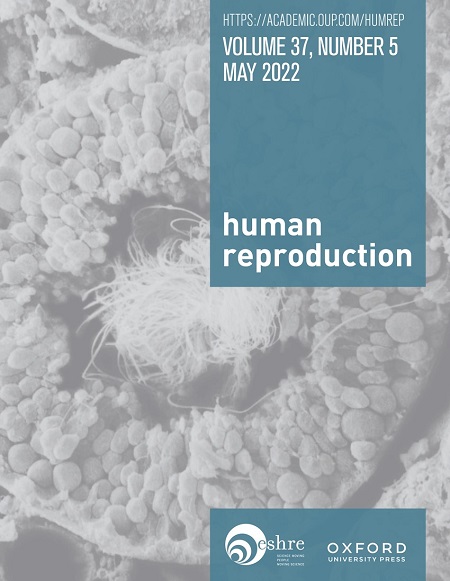Plasma metabolites associated with endometriosis in adolescents and young adults
IF 6
1区 医学
Q1 OBSTETRICS & GYNECOLOGY
引用次数: 0
Abstract
STUDY QUESTION What are the plasma metabolomics profiles associated with endometriosis in adolescents and young adults? SUMMARY ANSWER Our findings show dysregulation of plasma metabolomic profiles in adolescents and young adults with endometriosis, revealing systemic elevation of fatty acyls and ceramides in endometriosis cases compared to controls. WHAT IS KNOWN ALREADY Endometriosis is a gynecologic disease often presenting with severe pelvic pain impacting around 200 million reproductive-aged women worldwide. However, little is known about the pathophysiology and molecular features of endometriosis diagnosed during adolescence and young adulthood. STUDY DESIGN, SIZE, DURATION We conducted a cross-sectional analysis including 190 laparoscopically confirmed endometriosis cases and 120 controls who participated in The Women’s Health Study: From Adolescence to Adulthood, which enrolled participants from 2012 to 2018. Control participants were females without a diagnosis of endometriosis enrolled from the same clinics as the cases or recruited from the general population. Among the cases, 81 had blood samples collected before and after surgery. PARTICIPANTS/MATERIALS, SETTING, METHODS Plasma metabolites were measured in blood collected at enrollment using liquid chromatography–tandem mass spectrometry, and a total of 430 known metabolites were evaluated in our analysis. We used linear regression adjusting for age at blood draw, BMI, hormone use, and fasting status at blood draw. Metabolite set enrichment analysis (MSEA) was used to identify metabolite classes. Number of effective tests (NEF) and false discovery rate (FDR) were used for multiple testing correction. MAIN RESULTS AND THE ROLE OF CHANCE The median age was 17 years for endometriosis cases and 22 years for controls. The majority of endometriosis cases had rASRM stage I or II (>95%). We identified 63 plasma metabolites associated with endometriosis (NEF < 0.05). Endometriosis cases had higher levels of plasma metabolites associated with proinflammatory response [e.g. eicosatrienoic acid (β = 0.61, 95% CI = 0.37, 0.86)], increased oxidative stress response [e.g. xanthine (β = 0.64, 95% CI = 0.39, 0.88)], and downregulation of metabolites related to apoptosis [glycocholic acid (β = −0.80, 95% CI = −1.04, −0.56)]. MSEA revealed increased fatty acyls (FDR = 2.3e−4) and ceramides (FDR = 6.0e−3) and decreased steroids and steroid derivatives (FDR = 1.3e−4) in endometriosis cases compared to controls. When we examined the changes in plasma metabolite profiles before and after surgery among endometriosis cases, 55 endometriosis-associated metabolites significantly changed from before to after surgery. MSEA revealed steroids and steroid derivatives (FDR = 8.1e−4) significantly increased after surgery, while fatty acyls (FDR = 1.2e−4) significantly decreased after surgery. Ceramides did not change from pre- to post-surgery and were elevated in post-surgical blood compared to controls (FDR = 3.9e−3). LIMITATIONS, REASONS FOR CAUTION Our study population mainly consists of self-reported non-Hispanic, white individuals and endometriosis cases with superficial peritoneal lesions only, so the generalizability may be limited. Furthermore, despite our large study population of adolescents and young adults with endometriosis, sample size was limited to conduct detailed stratified analyses of plasma metabolomic profiles, especially by post-surgical pelvic pain outcomes. WIDER IMPLICATIONS OF THE FINDINGS Our study includes the utilization of state-of-the-art metabolomics technology with high reproducibility to comprehensively investigate the metabolites that were associated with endometriosis diagnosed in adolescents and young adults. Our results suggest a positive impact of endometriosis-related surgery for some, but not all, on systemic metabolic dysregulation in young patients with endometriosis. These results warrant further investigation on whether and how persistent systemic changes despite treatment may lead to long-term chronic disease risk among those diagnosed with endometriosis. STUDY FUNDING/COMPETING INTEREST(S) Financial support for establishment of and data collection within the A2A cohort was provided by the J. Willard and Alice S. Marriott Foundation, and support for assay costs was in part provided by the Peery family. This project was funded by Eunice Kennedy Shriver National Institute of Child Health and Human Development R21HD107266. S.A.M., A.L.S., and K.L.T. were supported by Eunice Kennedy Shriver National Institute of Child Health and Human Development R01HD094842. S.A.M. received grant funding from AbbVie, National Institutes of Health, Department of Defense, and Marriott Family Foundation; received honoraria from WERF, Huilun Shanghai, and University of Kansas Medical Center; travel support from SRI, ESHRE, FWGBD, University of Michigan, MIT, ASRM, LIDEA Registry, Taiwan Endometriosis Society, SEUD, Japan Endometriosis Society, NASEM, Endometriosis Foundation of America, Gedeon Richter Symposium at ESHRE; Board member receiving financial remuneration from AbbVie, Roche, LIDEA Registry, Editor of Frontiers in Reproductive Health, Roundtable participation for Abbott; Board member without financial remuneration from NextGen Jane and Statistical Advisory Board member of Human Reproduction; leadership role in Society for Women’s Health Research, World Endometriosis Society, World Endometriosis Research Foundation, ASRM, ESHRE. N.S. and K.L.T. receive grant funding from Aspira Women’s Health unrelated to this project. The remaining authors have no disclosures relevant to this manuscript. TRIAL REGISTRATION NUMBER N/A.血浆代谢物与青少年和年轻人子宫内膜异位症相关
研究问题:青少年和年轻人子宫内膜异位症的血浆代谢组学特征是什么?我们的研究结果显示,与对照组相比,子宫内膜异位症患者血浆代谢组学谱失调,揭示了脂肪酰基和神经酰胺的全身性升高。子宫内膜异位症是一种妇科疾病,通常表现为严重的盆腔疼痛,影响全球约2亿育龄妇女。然而,对青春期和青年期诊断的子宫内膜异位症的病理生理学和分子特征知之甚少。研究设计、规模、持续时间我们进行了一项横断面分析,包括参加《女性健康研究:从青春期到成年期》的190例腹腔镜确诊子宫内膜异位症患者和120例对照组,该研究纳入了2012年至2018年的参与者。对照受试者为未诊断为子宫内膜异位症的女性,来自与病例相同的诊所或从一般人群中招募。在这些病例中,有81例在手术前后采集了血液样本。参与者/材料、环境、方法采用液相色谱-串联质谱法测定入组时采集的血液中的血浆代谢物,并在我们的分析中评估了总共430种已知代谢物。我们使用线性回归调整抽血时的年龄、BMI、激素使用和抽血时的空腹状态。代谢物集富集分析(MSEA)用于鉴定代谢物类别。采用有效检验数(NEF)和错误发现率(FDR)进行多重检验校正。子宫内膜异位症患者的中位年龄为17岁,对照组的中位年龄为22岁。大多数子宫内膜异位症患者为rASRM I期或II期(95%)。我们鉴定出63种血浆代谢物与子宫内膜异位症(NEF <;0.05)。子宫内膜异位症患者血浆中与促炎反应相关的代谢物水平较高[如二十碳三烯酸(β = 0.61, 95% CI = 0.37, 0.86)],氧化应激反应增加[如黄嘌呤(β = 0.64, 95% CI = 0.39, 0.88)],与凋亡相关的代谢物[糖胆酸(β = - 0.80, 95% CI = - 1.04, - 0.56)]下调。MSEA显示,与对照组相比,子宫内膜异位症患者的脂肪酰基(FDR = 2.3e−4)和神经酰胺(FDR = 6.0e−3)增加,类固醇和类固醇衍生物(FDR = 1.3e−4)减少。当我们检查子宫内膜异位症患者手术前后血浆代谢物谱的变化时,55个子宫内膜异位症相关代谢物在手术前后发生了显著变化。MSEA显示,术后类固醇及类固醇衍生物(FDR = 8.1e−4)显著升高,而脂肪酰基(FDR = 1.2e−4)显著降低。神经酰胺从术前到术后没有变化,与对照组相比,术后血液中的神经酰胺含量升高(FDR = 3.9e−3)。我们的研究人群主要由自我报告的非西班牙裔、白人和仅伴有浅表腹膜病变的子宫内膜异位症患者组成,因此其通用性可能有限。此外,尽管我们研究了大量患有子宫内膜异位症的青少年和年轻成年人,但样本量有限,无法对血浆代谢组学特征进行详细的分层分析,尤其是术后盆腔疼痛的结果。研究结果的更广泛意义我们的研究包括利用具有高重复性的最先进的代谢组学技术,全面研究与青少年和年轻人诊断的子宫内膜异位症相关的代谢物。我们的研究结果表明,子宫内膜异位症相关手术对部分(但不是全部)年轻子宫内膜异位症患者的全身代谢失调有积极影响。这些结果值得进一步研究,尽管治疗,持续的全身改变是否以及如何导致诊断为子宫内膜异位症的患者的长期慢性疾病风险。研究经费/竞争利益(S) A2A队列的建立和数据收集的资金支持由J. Willard和Alice S. Marriott基金会提供,检测费用的部分支持由Peery家族提供。本项目由Eunice Kennedy Shriver国家儿童健康与人类发展研究所(R21HD107266)资助。S.A.M, a.l.s.和K.L.T.由尤尼斯·肯尼迪·施莱佛国家儿童健康与人类发展研究所R01HD094842资助。S.A.M. 获得了艾伯维、美国国立卫生研究院、国防部和万豪家族基金会的资助;获得世界自然基金会、上海汇伦和堪萨斯大学医学中心的酬金;SRI、ESHRE、FWGBD、密歇根大学、麻省理工学院、ASRM、LIDEA注册中心、台湾子宫内膜异位症学会、SEUD、日本子宫内膜异位症学会、NASEM、美国子宫内膜异位症基金会、ESHRE Gedeon Richter研讨会的差旅支持;从艾伯维、罗氏、LIDEA登记处获得财务报酬的董事会成员,生殖健康前沿编辑,参加雅培圆桌会议;NextGen Jane董事会成员,无财务报酬;Human Reproduction统计咨询委员会成员;在妇女健康研究学会、世界子宫内膜异位症学会、世界子宫内膜异位症研究基金会、ASRM、ESHRE中担任领导角色。N.S.和K.L.T.从阿斯匹拉妇女健康中心获得与本项目无关的拨款。其他作者没有透露与本文有关的信息。试验注册号n / a。
本文章由计算机程序翻译,如有差异,请以英文原文为准。
求助全文
约1分钟内获得全文
求助全文
来源期刊

Human reproduction
医学-妇产科学
CiteScore
10.90
自引率
6.60%
发文量
1369
审稿时长
1 months
期刊介绍:
Human Reproduction features full-length, peer-reviewed papers reporting original research, concise clinical case reports, as well as opinions and debates on topical issues.
Papers published cover the clinical science and medical aspects of reproductive physiology, pathology and endocrinology; including andrology, gonad function, gametogenesis, fertilization, embryo development, implantation, early pregnancy, genetics, genetic diagnosis, oncology, infectious disease, surgery, contraception, infertility treatment, psychology, ethics and social issues.
 求助内容:
求助内容: 应助结果提醒方式:
应助结果提醒方式:


